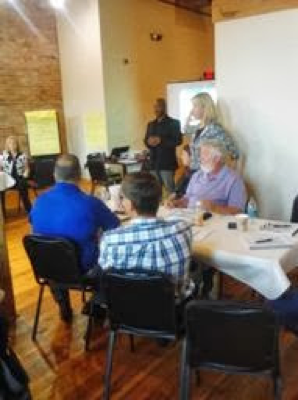It doesn’t matter how great you think your company is if your front-line managers think it sucks
Let me tell you a little story about front-line managers.
“Well, Master Trainer Rk, our business is a little bit different than most…” she said, smiling slyly.
In fact, after over 30 years as a trainer in one form, or with one title or another, I’d found that to absolutely be the case.
EVERY business is different.
This wasn’t the first time I’d had this conversation. In this instance, I was standing in a large room that looked as if it had once housed 30-40 cubicles, but those had been removed in the not too distant past, to make room for the 60 or so chairs and tables that now made up ‘Training Room 1’ for X-corporation. In order to receive the answer I’d just been given, I had asked the VP of Finance, Anne, to tell me about the specific kinds of opportunities her company had faced over the past few years.
And, while to some, her, “our business is a little bit different”, may seem predictable, for me, it is also an absolutely fantastic place to begin to learn about the training needs of an organization. I cannot tell you how often the first 20 percent of my time was spent trying to convince a specific organizational leader that their employees and their customers were in fact different in many regards from those of their competitors. And that jumping on to the latest, corporate training, (insert new buzzwords here), may or may not be the best fit for their organization.
Some believed me, some continued down their chosen path. The truth is, as a Corporate Master Trainer, it is not uncommon for me to make specific recommendations concerning a specific training path for a specific company. It is up to the company to decide which path they will take. Once decided, I simply offer the full weight of my knowledge and experience towards that goal.
No TWO businesses were alike.
I have trained in a multitude of environments ranging from major retailers, Ice-cream makers, manufacturers, school systems, universities, the Department of Defense, heck, even NASA, and from all of them I’ve learned two things:
- Most of them have been amazing in their desire to both, make their customers, (internal and external) happy, as well as
- Those with continued success seek out and learn from the day-to-day experiences of their front-line managers in order to measure and influence their business by doing the right thing for the organization.
That being said.
I’ve also found that the companies that were similar are similar in either being
- Great/Successful
- Workable/Successful
- Untenable/Possibly Successful
Got your attention?
Good.
Allow me to explain.
Great/Successful
A great, successful company is one that understands the value of a unifying vision for its day-to-day operations. One of the companies I have been impressed with on several occasions has been Wells’ Blue Bunny Ice Cream. This is one of those rare companies that always seem to hire the best candidates for specific positions, instead of simply filling a job description, and who understand that ‘family’ must include the people with whom you spend 8-12 of your 24 hours.
Comparable organizations understand that if you have been doing a yearly review with an employee, you haven’t been doing enough. This company understands that employees (especially their front-line managers) want to do their best for their company because it is what’s best for their own long-term careers. These companies understand that while they may not want, or be able to afford Google-esk, dry-cleaners on the premises and company chefs, they can have specialized benefits that reflect their specific business model and their specific employees. (These people read, and agreed with, that article with Richard Branson:
“Richard Branson: Why Customers Come Second at Virgin”.
These companies have detached their employees’ once-yearly incremental increases, for employee–specific, agreed-upon, merit-based increases.
“Your success is our success. Help us be successful.”
Workable/Successful
A workable/successful company understands that there are bricks missing from their yellow-brick road. Stated differently, they still have some growth necessary in order for their employees to feel as if they trust them. As a result, their customer-satisfaction/approval rating could use a boost.
These organizations understand what it means to have employees under-trained.

Master Trainer, Rk Springfield (TSI Experience), working with students during a breakout session.
They have one or two, (depending on the size of the organization), directors, managers, supervisors, and/or team-leaders who do NOT represent the culture of the organization. Those people not only leave them open to lawsuits, they also reduce that organizational culture to one of perfunctory officiousness at worse, and untrusting-politics at best. Most of the employees are capable of naming those few people, who make the company…what it is…, (these are the companies in which at least one employee in any given room can quote front-line managers as having said, “It is what it is, sorry”. Alternatively, to have the director who just hates his or her job, and seems to just come into work to make other people miserable. Yet, year after year, those same employees stay with the company, while good, possibly great employees go work for the competition.
These companies year after year will have their employees fill out forms telling the company what specific items they are willing to work on during the upcoming year to enhance their professional growth. (Moreover, who understand that as long as the paper work is filled out to HR’s satisfaction, it doesn’t matter if they actually mean it). After all, the person next to them has been here for 10 years, and every year he’s given a 4 out of 5 rating on his annual review. Even though he has filled out that report, (SMART goals), the exact same way for the last six years, and he always gets some sort of raise.
The exact same report, the exact same way.
Always some sort of raise.
SMART Goals
Experiential Training methods
True training is so much more than simply standing in front of a class. There needs to be an emotional connection that ties the new knowledge, skills or behavior or attributes to the participant, and his or her organization. Here are some experiential ideas.
Untenable/Possibly-Successful
There are many important factors for this category, so for the sake of time, we’ll explore just a couple of them.
Has someone you known ever worked for an organization that prided itself on what it used to do?
Whenever a new or slightly ambitious employee asks about a process or workflow innovation the inevitable answer they receive the standard answer, “Oh, we did that about ‘blank’ years ago. It was good, but we stopped.”
Otherwise known as the “Stop you. I’ve heard this one before,” argument.
Another sign that it may be time to look at your company’s success rate would, of course, be the employee retention rate and the number of retained employees when calculated in accordance with your customer base and your overall ROI or profits.
Here’s the situation: You’re a small company complete with a brick and mortar store and a rotating staff of 20 employees. You can find your front-line managers interviewing all year round—while your profits are shrinking. It’s time to ask some questions.
- Good or bad? Does your current employee population know what it means to be treated like one of your customers?
- Once every 1-3 years, it’s important to have either a customer focus training, or an internal appreciation day. The former speaks for itself, while the latter is a day in which the business takes a typically slow day and has the front-line managers show what they want to see in customer service. For Training Standards International, this goes beyond a ‘training day’, and gives the employees the chance to see what the manager and the business is looking for when it comes to customer service.
- Does your employee population mirror the population that it serves?
- Many of us have heard the complaint some people have about talking to a CSR who doesn’t represent them. It’s going to happen. However, as stated in the article Diversity Initiatives in the Workplace by Rose Mary Wentling of Berkeley:
“The impetus for diversity initiatives must come from awareness of the business implications: addressing the needs of workers, satisfying the demands of competitiveness, and fulfilling the requirements of the company’s role in the community. Organizations are willing to accept change related to diversity only if the potential benefits are clear and worthwhile”.
The reverse is also true. If your employee population does not reflect the diversity of your targeted customer base, customers are much more likely to go to a business that does. Keep in mind that it is 6-7 times more expensive to acquire a new customer than it is to keep a current one. If you are not certain about your customer base, or haven’t looked at the metrics in a while, start by asking your front-line managers, they will almost always have an idea.
MODEL WHAT YOU WANT TO SEE. PRAISE WHAT YOU WANT TO SEE MORE OF.
Sorry to leave that previous sentence dangling, but this one is so important that I didn’t want to wait.
Does the retained staff do an adequate job with the customers? Your front-line managers always know the answer to this better than almost any other position I have found. They are the people who usually know who’s going to do what long before even the other staff is aware of the upcoming decision.
I was recently in an independently owned Mexican food restaurant here in the Phoenix, and as I waited for my food, the owner walked in, talking very loud (presumably to let the staff know that he was the owner) and then proceeded to yell at the front-line manager about the state of the restaurant.
As he talked about the napkin dispensers being empty, and the noise from the AC unit, the other patrons and I looked first at what he was yelling about, and then we looked at the front-line manager. Finally, we looked at each other. Just before this debacle, another table and I had been having a discussion with the manager about how he seemed to be doing a lot. We had watched him seat us, bring water, answer the phone, make drinks and then vanish into the kitchen returning with another table’s appetizers. He explained that since it was slow during these hours, and his server was sick, that it was just one of those days, but he liked being able to talk to guests this way.
As the owner went to the back of the house, presumably to yell at other employees, the front-line manager, who had been the person to come to my own table to take my order, came back and apologized. Apologized for the owner.
I smiled and simply said “Wow.”
The older couple sitting two tables over from us was much more vocal about him “having to put up with that guy,” going so far as to say that they were going to call to complain about it. I smiled again.
Complain to whom?
“It’s o.k. I’ve already found another job. My two weeks is already on my desk in the back.”
Ah. Untenable.
Now, luckily this particular example is extreme. After all, what Director VP or C-level leader would simply begin to make declarative statements to his or her front-line manager without asking a question first?
We have all kinds of holidays and all kinds of days of appreciation, and we certainly don’t want to take away from any of them. Instead let’s add one for one of the largest (largely unsung working populations out there) our customer and employee facing front-line managers. After all, they are the ones on the Front-line.
Experiential Training Question:
If it takes a village to raise a child, what does it take to make a business successful?






Leave a Comment